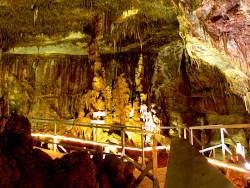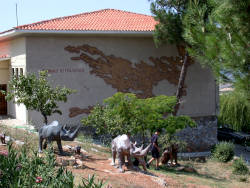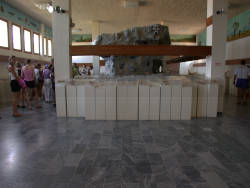Σπηλαιο Αρχανθρωπων Πετραλωνα
Spilaio Archantropon Petralona - Spilaio Petralona - Petralona Cave - Kókkines Pétres - Cave of the Red Stones
Useful Information



| Location: |
Petralona 630 80.
Near Petralona, Chalkidiki, Macedonia (Makedonia). (40.3734968, 23.1686930) |
| Open: |
All year daily 8-20. Closed 01-JAN, 25-MAR, Easter Sunday, 01-MAY, 25-DEC, 26-DEC. [2024] |
| Fee: |
Adults EUR 8, Children (0-25) free, Seniors (65+) EUR 4. NOV to MAR: Adults EUR 4. [2024] |
| Classification: |
 Karst Cave Karst Cave
|
| Light: |
 Incandescent Incandescent
|
| Dimension: | L=200 m, Ar=10,400 m. |
| Guided tours: |
D=30 min. V=50.000/a [2023] |
| Photography: | very strictly forbidden, offenders are publicly insulted |
| Accessibility: | no |
| Bibliography: |
A. N. Poulianos (1971):
Petralona: A Middle Pleistocene Cave in Greece,
Archaeology 24(1971) 6-11.
L. Reisch (1980): Pleistozän und Urgeschichte der Peloponnes, Habilitationschrift, Friedrich-Alexander Universität, Erlangen; Nürnberg 1980. 
G. Hennig et al. (1981): ESR-Dating of the Fossil Hominid Cranium from Petralona Cave, Greece, Nature 292(1981) 533-536. A. N. Poulianos (1982): Die Höhle der Petralonischen Archanthropinen, Bibliothek der Anthropologischen Gesellschaft Griechenlands, Athen, 1982 


A. Poulianos et al. (1982): Petralona Cave Dating Controversy, Nature 299 (1982) 280-282. A. G. Wintle, J. A. Jscobs (1982): A Critical Review of the Dating Evidence for Petralona Cave, JAS 9(1982) 39-47. Georgios Lazaridis (2009): Petralona Cave: Morphological Analysis and a new Perspective on its Speleogenesis, Hypogene Speleogenesis and Karst Hydrogeology of Artesian Basins, Ukrainian Institute of Speleology and Karstology, Special Paper 1, 2009. academia.edu |
| Address: |
Ephorate of Palaeoanthropology-Speleology, Navarinou 28, 55 131, Kalamaria, Thessaloniki, Tel: +30-23730-73365.
E-mail: |
| As far as we know this information was accurate when it was published (see years in brackets), but may have changed since then. Please check rates and details directly with the companies in question if you need more recent info. |
|
History
| 1959 | discovered by Filippos Chantzaridis from Petralona. |
| 1959 | first excavations by Ioannis Petrocheilos. |
| 1960 | skull of an Archanthropus discovered by Christos Sarijannidis. |
| 1960 | excavations by research groups from the University of Thessaloniki. |
| 1965-1968 | excavation of section A by Dr. Aris N. Poulianos. |
| 1971 | Dr. Aris N. Poulianos founds the Anthropological Association of Greece (ASS). |
| 1974 | entrance tunnel built. |
| 1974-1975 | excavation of section S.A1 by Dr. Aris N. Poulianos. |
| 1978 | electric light. |
| 1979 | ASS makes contract for the cave with the Greek Organization of Tourism (G.O.T.). |
| 1983 | all excavations at the site forbidden by the government, no reason provided. |
| 1998 | research access to the cave allowed on the basis of a court decision. |
| 04-APR-2011 | Anthropological Association of Greece expelled, cave now managed by Greek Archeological Service. |
| 01-JAN-2019 | cave closed for renovation. |
| 26-AUG-2024 | cave reopened to the public. |
Description




Σπήλαιο Πετραλώνων (Petralona Cave) is a major tourist attraction of the Halkidiki peninsula south of Thessaloniki. And it is a famous bone cave, especially for human and hominid remains. Here the oldest human remains of Greece were discovered, and the number and continuity of remains is extraordinary.
The cave was discovered by the goat shepherd Filippos Chantzaridis from Petralona, who heard the sound of water from a hole in the rocks. It took some time to persuade some men from the town, but in 1959 some men went to this place and dug a 7 m deep hole in the search of water. What they found was the cave. The first research of 1959 was made by the big old man of Greek speleology, Ioannis Petrocheilos. He found numerous bones of animals, many of them covered with cave coral. One year later, a human skull was discovered, hanging at the wall about 30 cm above ground, where it was held by sinter. The skull of an Archanthropus, a transitional type between Homo erectus and Homo sapiens, was a scientific sensation. It was the first discovery of an Archanthropus in Greece and showed that this cave was visited long ago.
The major excavations were made by the anthropologist Dr. Aris N. Poulianos, who spent many years in the caves. He published many articles in various periodicals, especially in Anthropos, the Greek Anthropology Magazine. He wrote a book, which is available in Greek, English and German. His theories always were an affront to the established palaeontology, so he had various problems. However, the controversy, especially on the topic dating, is easy to discover in the little literature list above. He estimated the age to be 700,000 years, others estimated 70,000 years, geophysical dating revealed an age between 160,000 and 240,000. However, he cannot be convinced by simple facts, and being quite charismatic he even convinced other scientists.
The finds, including bones of hyenas, lions, deer and other animals, are presented to the visitors in the nearby museum. Numerous bones, skulls and stone tools made of flint, bauxite and quartz. Many bones are encrusted with cave coral, some are part of a bone breccia. All exhibits are explained in Greek and English. This museum is really worth a visit!
The central exhibit is the reconstruction of the famous Archanthropus, which is called Archantropus’ Mausoleum. This title has obviously nothing to do with reality. The skeleton is of a 30-year-old male, a very old man as most individuals died before they were 20 at this time. He lived probably here, because this is the driest and most comfortable place of the cave. Probably he was not able to move very much, and so he was looked after by other members of the group. Most likely, he died peacefully of old age at this location.
Pretty strange is the fact that his head was sticking at the wall 30 cm above the floor. The explanation is simple: after the man died with the head touching the wall, his skull and the wall were covered by a thin layer of calcite, a crust of cave coral which glued the scull to the wall. Later climate changed again, and the secluded spot became drier, the thick layer of clay on the floor dried and shrunk, and the floor went down 30 cm. The skeleton moved down with the floor, but the skull was glued to the wall and stayed where it was.
The cave itself, despite its major tourist attraction status, is definitely not worth a visit. Tours are held only in Greek, which seems a bit arrogant with so many foreign visitors. There is no cave description, no handouts or brochures, no guidebook. A short explanatory text hanging in the window of the kiosk is all you get. But the signs, which inform you that photography is forbidden, are big and in multiple languages. They even demand you not to take a camera into the cave, a demand we never heard before. It has the drawback that you have to leave your expensive camera in the car on the unsupervised parking lot, not really a good idea. And beware to show a camera inside, you will be threatened by the guide! He is very good at doing this in English, even if he is not able to say a few words about the cave in English. The postcards are few, and, to be honest, pretty ugly.
The cave itself is nice but nothing special. The tour is pretty short and shows more or less the main chamber of the cave. The tour emphasizes on the excavations, the speleothems, which are quite nice, are neither mentioned nor well illuminated. The cave shows some cave coral and some helictites.
Our recommendation: if you are at Thessaloniki and want to visit a cave, go to
 Agios Georgios
and not to Petralona.
Agios Georgios
and not to Petralona.
Update 2003: There are now tours also in English, depending on the number of foreign visitors. This is an excellent idea, but as the tours are made only in a single language, there may be some delay as you wait for a tour in your own language. The tours are focused on the archaeological importance of the cave and only very few things of general interest are explained.
Update 2011: The cave was managed by the Anthropological Association of Greece (AAG) which is a non-government non-profit organisation founded by Aris N. Poulianos. While it is obviously a sort of "holding" which does the paperwork for his scientific work, his conferences and the show cave, it is also obviously a good way to get tax deductions. In 2011 the AAG was violently expelled (their own words). The management was given to the Αρχαιολογική Υπηρεσία (Greek Archaeological Service), a state service under the auspices of the Greek Ministry of Culture. The AAG were quite angry and accused the new operator of incompetence and illegal activities. He even said, he and his wife were attacked at home by their agents. They also claimed the museum was downsized, the employees fired and replaced by untrained personnel, open hours reduced and there were rumors of "lost" artefacts. International scientists were astonished about the whereabouts of important exhibits, the International Union of Speleology requested to know if and how scientific access and the protection of the artifacts was handled. Again charismatic Poulianos was able to convince people of his strange ideas. However, the AAG cited "scientific" articles in the journal Ancient Origins, which publishes articles on cryptoids, ancient giants, alchemy and the Egyptian demonic calendar. In other words the magazine is dedicated to conspiracy theories and ancient alien stories. We think that’s the right place for his paranoia.
Update 2019: The cave was closed for renovation and remains closed. We can only hope that the "renovation works" do not include destruction of archaeological material in the cave. While we do not believe Poulianos’ conspiracy theories, we are also aware that bureaucratic incompetence and ignorance have caused the destruction of several important archaeological sites.
This story is a good example of how such things should not be handled. Both sides, the government represented by the Greek Archaeological Service, a part of the Greek Ministry of Culture, and the Anthropological Association of Greece (AAG) which is the company of Poulianos, are actually unsuitable to manage the cultural heritage of us all. The state bureaucracy is dangerous for its cluelessness, while a private owner of a cultural site is also a bad idea, especially if he is a 98-year-old conspiracy theorist. Even worse are decades of warfare between two parties. If you believe the stories, the electricity and water supply was sabotaged and Poulianos was threatened and attacked at home by government agents. The loser in the whole mess is the truth and the scientific work, no scientist was able to do research for decades while the war was going on. Irreplaceable artefacts have disappeared, probably forever, while each party accuses the other of stealing them.
Update 2024: After five years of renovation, the museum and the show cave were finally reopened. The pro side: it is open again, and the virtual tour actually shows no changes so there is no reason to think they destroyed something. On the con side: there are actually no changes at all, they did not even replace the old and rusty railings from the 70s. In other words, the necessary renovations were not done. Also, their website does not offer basic information about the tours. It’s unclear if it is now allowed to take pictures, how long the tour takes, if the museum is included in the cave ticket or free as before, and much more. In short: this cave continues the tradition to be an annoyance very well!
- See also
 Search DuckDuckGo for "Petralona Cave"
Search DuckDuckGo for "Petralona Cave" Google Earth Placemark
Google Earth Placemark OpenStreetMap
OpenStreetMap Petralona cave - Wikipedia (visited: 19-APR-2021)
Petralona cave - Wikipedia (visited: 19-APR-2021) Petralona Cave, official website (visited: 08-OCT-2024)
Petralona Cave, official website (visited: 08-OCT-2024) Σπήλαιο Πετραλώνων, official website
Σπήλαιο Πετραλώνων, official website  (visited: 09-OCT-2024)
(visited: 09-OCT-2024) Petralona Cave | Geological shapes [Reopened] (visited: 08-OCT-2024)
Petralona Cave | Geological shapes [Reopened] (visited: 08-OCT-2024) THE 40th ANNIVERSARY SINCE THE DISCOVERY OF THE PETRALONA ARCHANTHROPUS’ SKULL (visited: 09-OCT-2024)
THE 40th ANNIVERSARY SINCE THE DISCOVERY OF THE PETRALONA ARCHANTHROPUS’ SKULL (visited: 09-OCT-2024)
 Index
Index Topics
Topics Hierarchical
Hierarchical Countries
Countries Maps
Maps